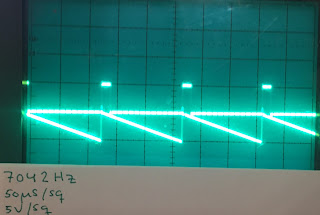This constraint is there for a good reason, as we need a perfect match between charging voltage and reset time for the saw wave to get the correct amplitude. If we choose to change the charge voltage at any given time, without changing the reset timer, the amplitude of the first cycle after the change will be either too high or too low.
Idea 1:
Ideally, we should change the remaining time of the reset timer too. This would be a case of subtracting the current remainder from the new period timer value, correcting for the time the calculation takes, and then updating the timer - IF the time the calculation took was less than the remaining time.
This is slightly more complicated than what it sounds like. As the current timer and the new timer may not have the same prescaler, we need to take this into account when calculating the correct reset values. We also need to make sure we don't mess up the reset pulse timer.
Idea 2:
A different approach would be to do the first reset in hardware. If we connect the saw output to a comparator, and check if the level is just slightly larger than the normal, correct amplitude, we could trigger a reset using the sync input, preventing a large amplitude error. The amplitude error that is inevitable because the reset point must be larger than the correct amplitude is hopefully small enough to be inaudible. This lets us change the charging voltage at any time and still not get a large amplitude error.
This will fix the case where the amplitude is too large, but the case where it is too small (e.g. the new charge voltage is lower) will not be fixed. To fix this, we must also reset the period timer at the same time. Doing so guarantees that the charging time is at least long enough for the new charging voltage to fully charge the cap. In most cases the charing time will be too long as it adds to the time already elapsed since the last reset, but then the previous comparator fix will reset the period at approximately the right time.
The disadvantages to this method may be:
- Charging time may change slightly when the ambient temperature changes. Resistor values barely change so I have to check the effects on the charge capacitor.
- The amplitude of the first period will always be slightly wrong after a frequency change. Not sure if that will be audible. It may possibly only be a problem for fast changing pitch.
Idea 3:
A third method would be to always reset the cap at the instant a frequency change occurs. The timing will then be as accurate as possible. The main disadvantages are
- The saw wave will always start at the same position. Two DCOs running in parallel will then be in almost perfect sync.
- A fast changing pitch will reset the timer multiple times per second, possibly hundreds or thousands of times. At low frequencies this means no saw wave runs to completion, giving us a way too low amplitude (though shifted to the maximum).
I will give the choice between 1 and 2 a more thorough thought and try to build 2 to see how it feels like. All options may be retrofitted to the current DCO even if the PCB has been created, as the comparator circuitry can be housed outside of the DCO itself..










